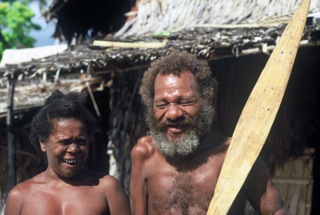Alata System
Lau from northeast Malaita originally migrated down to Port Adam Passage at least twelve generations ago, yet maintain close social ties. The Lau brought down their fishing-based culture, including powerful spirits for calling in fish and hunting dolphins. They transplanted the alata system.
As they settled Fanalei, a natural island at the south entrance to Port Adam Passage, they started creating alata--reefs historically recognized as good fishing grounds that are declared clan property. At the far north end of the passage, some of the Lau built an artificial coral islet--for which the Lau are noted—creating the sister fishing village of Walande.
Controlling access to the Passage, the Lau drew a sharp distinction between themselves and the Sa’a-speaking “bush” people who inhabit the mainland of Small Malaita. Lau and Sa’a people sometimes intermarried to increase access to each other’s specialized resources from saltwater fishing and bush gardening.
 Saltwater and bush clans around the Passage mostly fought among themselves, the weaker clans hiring ramos as mercenaries for protection. Ramos earned respect and custom wealth, from reef and land rights to fathoms of red shell money--beads drilled from spondylus shell that are Malaitan custom wealth like dolphin teeth. Lau clans dominated Sa’a clans in the raiding warfare.
Saltwater and bush clans around the Passage mostly fought among themselves, the weaker clans hiring ramos as mercenaries for protection. Ramos earned respect and custom wealth, from reef and land rights to fathoms of red shell money--beads drilled from spondylus shell that are Malaitan custom wealth like dolphin teeth. Lau clans dominated Sa’a clans in the raiding warfare.
The Fanalei clan with the most powerful ramo became the chiefly clan and accrued the alata. Older chiefly clan members still recall fight stories that describe how they won the alatas from weaker Lau clans as payment for protection. These fight stories today can justify political power and property rights. But if mentioned in public in front of those clans who had to hire ramo, shame and anger surface. The stories have poignant ability to spark brawls among young men who head off to labor where everyone mixes, are not entrusted with fight stories until they are safely home and not tempted to one-up each other socially with such volatile custom knowledge.
According to Lau custom, an alata was created by the first man to have a team set his own huge net around an unclaimed reef and haul in a plentiful catch. This net-owner gained the right to name that reef as a new alata for his clan. Only someone powerful enough to transport the net with the requisite giant canoe and be able to control a net-fishing team could establish an alata.
Pax Britannica froze alata ownership in perpetuity. Weaker clans no longer hired ramo who could demand payment in alata. In the days of ramo warfare, the clan leader was often the ramo. The clan payback “fight” system had left today's Fanalei chiefly clan holding all alata.
Today's alata cannot be transferred without the consent of the clan as a body. Stewardship of an alata is ceded to an individual clan member, but married women are excluded from being named as the alata “owner”-- the steward. In Fanalei, the “owner” is the chief.
Technically, only the clan that owns the alata can use it for activities other than net-fishing, such as spearfishing, line fishing or shell-diving. It remains taboo for someone outside the clan “to fish all about” in an alata--such behavior carrying a compensatory custom fine. Clan ancestors are thought to reveal steward if someone is poaching to the alata “owner”. Canoes were not permitted to pass over alata but had to travel through the channels, inadvertently protecting shallow corals from paddles, and now outboard motors.
Adi--a special fishing ban inside an alata for six months up to two years--is a central control mechanism within the alata system. In between net-fishing on a particular alata, the owner could impose an adi to reserve fish stocks for a special occasion like a feast or to barter for custom wealth needed for a bride price.
Calling for an adi embodied the whole political-social-technological-economic-religious complex whereby the alata owner and his clan displayed and earned power and control. The Lau did not consider their alata system to be management per se, with the attendant concept of conservation. Yet in current management terms, it functioned to limit fishing effort as a corollary to their cultural sense of power. Thus Lau used the system to store up fish in exchange for custom wealth/an event, or to gain political largess through magnanimously granting fishing permission to other clans.








